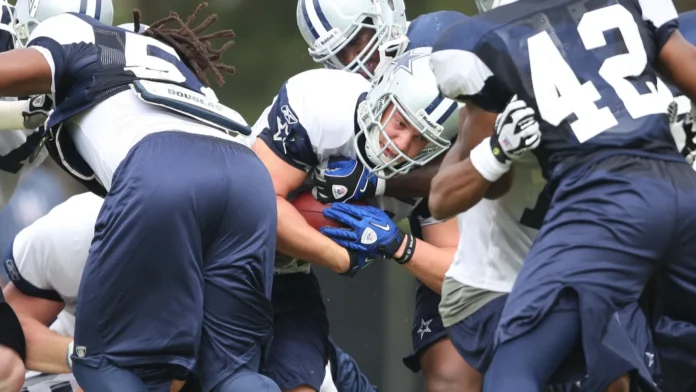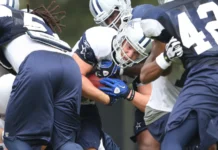
In the NFL, fans often watch the flashy touchdowns, incredible catches, and heroic quarterback plays.
But the real work that often decides games happens in the trenches, with the offensive line.
Offensive linemen are rarely in the spotlight, yet their performance can be the difference between a win and a loss. They protect the quarterback, create opportunities for the running game, and help the offense operate smoothly.
Pass Protection Is Key
One of the biggest responsibilities of the offensive line is keeping the quarterback safe during passing plays. On every drop back, the linemen face defensive players who are trying to disrupt the play.
If they fail, the quarterback faces pressure, hurried throws, sacks, or even turnovers. A quarterback under constant pressure cannot perform at a high level, no matter how talented he is.
Pass protection is more than just preventing sacks. It is about giving the quarterback enough time to read the defense, make decisions, and deliver accurate throws.
A strong offensive line allows quarterbacks to step into throws, wait for receivers to get open, and avoid mistakes. A weak line, however, forces hurried decisions and reduces overall offensive efficiency.

Time Makes the Difference
The key to successful pass protection is time. The longer the offensive line can hold off defenders, the more options the quarterback has. This is why teams invest so much in training, coaching, and coordinating their line.
Every split second gained in the pocket allows the quarterback to execute better plays. Even one extra second can mean the difference between a completed pass and an interception.
Great offensive lines communicate on the field, call out stunts, and adjust protections in real time. This kind of coordination is invisible to many fans but is crucial to winning games.
Pressure and Its Consequences
Even partial pressure affects quarterback performance.
A lineman may not allow a sack, but if the defender is closing in quickly, the quarterback may throw earlier than planned or make a less accurate pass.
Good offensive line play doesn’t always result in visible highlights, but it significantly improves passing efficiency and keeps drives alive.
Fueling the Running Game: Why Run Blocking Matters
Offensive lines are also essential for the running game.
A running back relies on his blockers to open lanes and create opportunities to gain yards. When the line executes their assignments effectively, the back can pick up big gains and maintain momentum for the offense. When they fail, runs are stuffed for minimal gain, drives stall, and the team falls behind.
The Mechanics of Run Blocking
Run blocking is a combination of power, technique, and teamwork. Linemen use leverage, footwork, and hand placement to push defenders aside. They must coordinate with each other to create openings and sometimes block defenders two levels deep. Good blocking requires not only strength but timing and precision.
Consistency is also important. When the same offensive line plays together frequently, they understand each other’s tendencies. They know when to double-team a defender, when to release to the second level, and when to adjust for defensive shifts. This teamwork creates more reliable running opportunities for the offense.

Controlling the Game Clock
Effective run blocking allows teams to control the game clock. Sustained running plays keep the defense on the field longer, wear them down, and allow the offense to dictate the pace of the game.
Controlling the clock also opens up play-action passes, which can be particularly devastating when defenders are focused on stopping the run. Teams that can run effectively are often better equipped to handle late-game situations and close contests.
Impact of Continuity
Keeping the same offensive line together throughout a season can significantly improve run-blocking performance. When linemen develop chemistry over multiple games, they make fewer mistakes, react faster to defensive shifts, and create more consistent running lanes. In contrast, teams that frequently rotate linemen may struggle to establish a strong running game.
Why Chemistry and Continuity on the Line Are Game Changers
Having talented players alone is not enough. How well the linemen work together and maintain a stable unit over time can make a huge difference in performance. Continuity and chemistry often separate good offensive lines from great ones.
Reducing Mistakes
A line that plays together consistently makes fewer mental errors. Linemen anticipate each other’s movements, adjust to defensive tactics collectively, and communicate effectively. These subtle factors reduce blown blocks, prevent missed assignments, and improve overall offensive efficiency.
Fewer Penalties
Penalties, especially holding, can kill offensive momentum. Teams with consistent offensive lines often commit fewer penalties because players are familiar with each other’s pace and timing. Continuity helps linemen operate smoothly and reduces costly mistakes.
Supporting Both Run and Pass
Strong chemistry on the line benefits both the passing and running game. When linemen work well together, they can both protect the quarterback and open lanes for the running back in the same play. This dual effectiveness keeps defenses off balance and makes it more difficult for opponents to anticipate play calls.
Real-World Impact
Teams with stable, high-performing offensive lines often enjoy more offensive success. They allow fewer sacks, create better running opportunities, and reduce turnovers. Conversely, teams with frequent changes or inexperienced linemen often struggle to generate consistent offensive production. Continuity provides a foundation that allows all skill players to perform at their best.
Frequently Asked Questions (FAQs)
Q1: If quarterbacks are so important, why do we talk so much about linemen?
Even the best quarterback cannot perform without protection. A weak offensive line forces hurried throws, increases the risk of sacks, and limits the quarterback’s ability to make plays.
Q2: How can we measure how good an offensive line is?
Metrics include sack rates, pressure allowed, and measures of run-blocking efficiency. Teams and analysts also evaluate continuity, chemistry, and how well the line works together to create time and space for the offense.
Q3: Does continuity on the line really make a big difference?
Yes. Teams that keep the same five-man unit on the field consistently usually perform better. They allow fewer sacks, make fewer mistakes, and generate more successful rushing plays.
Q4: Can a bad offensive line ruin a great running back?
Absolutely. Even the most talented running backs need lanes to run through. If blockers fail to create space, the back is tackled quickly, limiting overall effectiveness.
Q5: Why don’t fans notice good line play more often?
Line play is subtle. Fans usually notice mistakes, like a blown block or a sack, but not the consistent execution that prevents those mistakes. The work of linemen is mostly behind the scenes, but is crucial for offensive success.
Conclusion
- Offensive line play is critical for both the passing and running game.
- Strong lines give quarterbacks time and reduce pressure, improving overall offensive efficiency.
- Effective run blocking requires technique, timing, and coordination.
- Continuity and chemistry among linemen reduce mistakes, penalties, and allow skill players to perform at their best.
- Even though linemen rarely get the spotlight, their role is foundational to winning games and sustaining offensive success.
Read More
- How NFL Training Camps Have Become a Cultural Event
- How Rule Changes Keep the NFL Evolving
- Forgotten NFL Teams and Why They Disappeared
This article was made with AI assistance and human editing.



